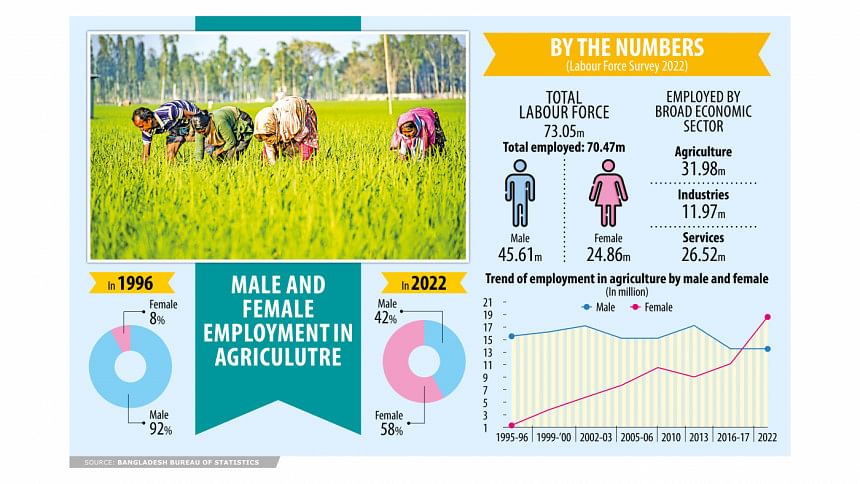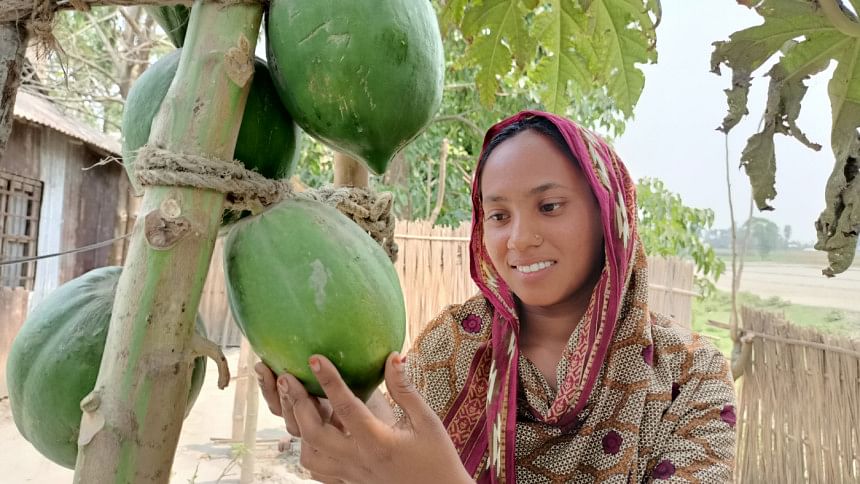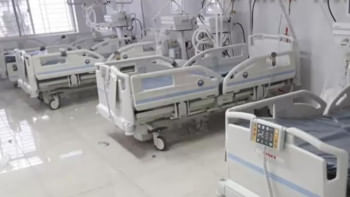Women outnumber men in farming sector

More women are joining the agriculture sector in Bangladesh as their job opportunities in industries, especially garment factories, have stagnated and men switch to non-farm sectors amid increased mechanisation of farming activities.
Currently, 18.4 million women toil in the agriculture sector, making up 58 percent of the total workforce in the key area of the economy. On the other hand, the number of men involved in farm activities stands at 13.55 million, according to the Labour Force Survey of the Bangladesh Bureau of Statistics (BBS).
In the last two and a half decades, the share of male workers in agriculture, which also includes fisheries, livestock and forestry, dropped 13 percent from 15.58 million whereas employment in the farm sector doubled to nearly 32 million during the period.
This gap was filled by an increased entry of women. Since 1995-96, women's employment in farm jobs jumped 17 times.
"Due to the expansion of the agricultural sub-sectors in rural areas, women's participation has increased significantly, not only in numbers but also in the sub-sectors," said Sharmind Neelormi, a professor of economics at Jahangirnagar University.
There are some agriculture sub-sectors where women dominate, namely poultry, dairy, and cultivating commercial vegetables.
Besides, she said, there is a lack of jobs for women in sectors other than garment, the biggest employer of female workers.
"Often, women are offered jobs where they can be paid less than men. They are treated as less paying job-holders," said Prof Neelormi.
According to the economist, in the garment sector, a piece of labour-saving technology has been used for a long period. As a result, new job opportunities are shrinking although the number of women in the workforce is increasing.
"As they don't have enough job opportunities in the garment and other sectors, women have to be involved in agriculture or agri-aligned jobs even when the employment is not lucrative."

Prof Neelormi thinks poverty has pushed women towards farming.
BBS data showed that the female labour force participation rate increased steadily over time. In 1995-96, the rate was 15.8 percent. Two and half decades later, it grew to 43 percent.
The farming sector absorbed 74 percent of the total employed female workers of 24.86 million in 2022.
Sayema Haque Bidisha, a professor of economics at the University of Dhaka, said a good number of male workers have migrated to the urban areas and it is not always possible for women to leave their households for various reasons.
She cited that women's participation in the garment sector has declined to 65 percent from 85 percent in the last one decade.
In a paper on the determinants and changes in women's participation in agriculture in Bangladesh from 1988 to 2008, noted economists WMH Jaim and Mahabub Hossain said the shift in participation of male labourers from agriculture to non-farm activities has created a tremendous worker shortage in the agricultural sector.
"This largely explains the gradual increase of female participation in agriculture."
The paper which was based on a study that found that in the non-farm sector, the opportunities for jobs for the male labour force have increased over time. For the female labour force, it has decreased to some extent.
Besides, higher agriculture mechanisation, which refers to the use of machines for tillage, irrigation and threshing of crops, is another reason.
The involvement of adult women increased in livestock and poultry production and homestead gardening. And the credit support from NGOs and microfinance institutions has facilitated this change.
However, women labourers in the farm sector face wage discrimination. Their workloads have also increased because of traditional gender roles since they have to perform some socially-determined gender-specific household activities like taking care of children and the elderly. This means they have to shoulder the compounded pressure of productive and reproductive work.
Rushidan Islam Rahman, a former research director at the Bangladesh Institute of Development Studies, said the growth of women's employment in agriculture can't be an effective route to gender equality for two reasons.
First, it resulted from a reduction in the absolute number of women employed in the industrial sector. Second, women's overcrowding in self-employment in agriculture without their increased ownership of land or agricultural assets led to a sharp decline in productivity.
These forces led to a decline in the real wage of women and a rise in the male-female wage ratio as shown by the LFS 2022, she said.
"Such changes imply that women's employment in agriculture is distress-driven. To reverse the situation, there is no option but to create employment opportunities with higher productivity through labour-intensive industrialisation."
Sadika Haque, a professor of agricultural economics at the Bangladesh Agricultural University, said the work hours of women in the farm sector are increasing while it is decreasing for men.

However, because of the engagement in the farm sector, women's sleeping time has declined as they have to perform household chores, she said in a recent study.
"Household tasks should be done by all irrespective of gender to lessen the pressure on women. A change in mindset and attitude is necessary."
The increased share of women in the labour force, however, does not mean gender equality and empowerment of women in the real sense.
Prof Sadika noted that though there is a provision of land rights for women, they, in the true sense, can't exercise their rights and take control of the property because of social norms and attitudes.
"This needs to be changed."
She says it is necessary to ensure women's access to and control over resources.
"A change in social attitudes is required to guarantee gender equality. The role of the state is vital here."
In a write-up, Dirk Reinermann, director of the International Development Association Resource Mobilisation of the World Bank, said the global fight for gender equality rages on. Women and girls around the world still face many barriers to equal rights and opportunities.
"But we know that a world with equal opportunity for all is not only a matter of fairness and justice, it is also essential for sustainable development."


 For all latest news, follow The Daily Star's Google News channel.
For all latest news, follow The Daily Star's Google News channel. 





Comments